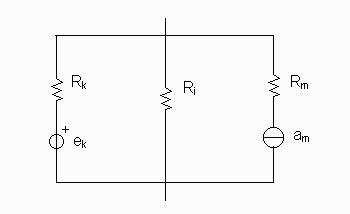 | ||
In electrical engineering, Millman's theorem (or the parallel generator theorem) is a method to simplify the solution of a circuit. Specifically, Millman's theorem is used to compute the voltage at the ends of a circuit made up of only branches in parallel.
It is named after Jacob Millman, who proved the theorem.
Explanation
Let ek be the voltage generators and am the current generators.
Let Ri be the resistances on the branches with no generator.
Let Rk be the resistances on the branches with voltage generators.
Let Rm be the resistances on the branches with current generators.
Then Millman states that the voltage at the ends of the circuit is given by:
It can be proved by considering the circuit as a single supernode. Then, according to Ohm and Kirchhoff, "the voltage between the ends of the circuit is equal to the total current entering the supernode divided by the total equivalent conductance of the supernode".
The total current is the sum of the currents flowing in each branch.
The total equivalent conductance of the supernode is the sum of the conductance of each branch, since all the branches are in parallel. When computing the equivalent conductance all the generators have to be switched off, so all voltage generators become short circuits and all current generators become open circuits. That's why the resistances on the branches with current generators do not appear in the expression of the total equivalent conductance.
